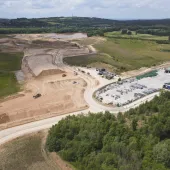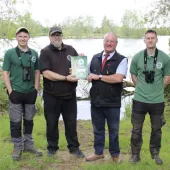Hills Waste Solutions put the environment first

Wiltshire Wildlife Trust and Hills create new home for bees in North Swindon
HILLS Waste Solutions and Wiltshire Wildlife Trust have joined forces to give declining bee populations a helping hand with the creation of a crucial new diverse habitat for wildlife on a closed section of a landfill site in North Swindon.
Part of the Chapel Farm landfill site is undergoing works to transform the area into a haven for bees, insects, small mammals, ground nesting birds and reptiles.
Mike Webster, group director of Hills Waste Solutions, said: ‘The landfill operations at Chapel Farm are due to end in 2014 and Hills will remain responsible for the long-term aftercare of the site. As part of our restoration planning we have been working with Wiltshire Wildlife Trust on this project to create a bee-friendly habitat that will also become a haven for other wildlife.’
An area measuring 18.5 hectares will be transformed into wild flower meadows with a small orchard, both of which will provide an important source of food and pollen for a range of invertebrates, including queen and worker bumblebees. Some areas of bare ground will remain as these provide suitable nesting sites for solitary bees and wasps.
Stephen Davis, head of conservation policy at Wiltshire Wildlife Trust, said: ‘Having lost 97% of our wild flower meadows, it is fantastic news to see the closed section of the landfill site being restored to a wildflower habitat for bees and other insects.
‘Over time this area will continually improve to support a great diversity of wildlife. It is also the perfect complement to the plans for a nature park being developed adjacent to the River Ray just to the South.’
The project is being delivered in a number of phases. Pipework and cables, which are a necessary part of the environmental management of the landfill site, have been buried and the soil surface prepared in readiness for the planting of a hay meadow next summer.
The next phase will be to erect stock proof fencing to protect the young trees in the orchard, and log piles that provide shelter for terrestrial invertebrates, small mammals, reptiles and amphibians. Nesting sites for solitary bees will also be created.
Hedgerows of willow, wild cherry, hawthorn and blackthorn will be planted to provide wildlife corridors for a range of species such as nesting birds, small mammals, badgers, foraging and commuting bats, and terrestrial invertebrates.
This variety provides valuable nectar and pollen for foraging bees from early spring until late summer. The area will provide a good quality habitat for small mammals and naturally excellent foraging for raptors such as barn owls and kestrels. Raptor perching posts will be installed to make up for the initial lack of mature trees and hedgerows in the area.
The final phase of the project will begin in spring 2014 with the installation of bee hives and following that, in early summer, the area will be lightly ploughed and green hay, rich in meadow plant seeds and harvested from a local donor site, will be spread onto the surface.









